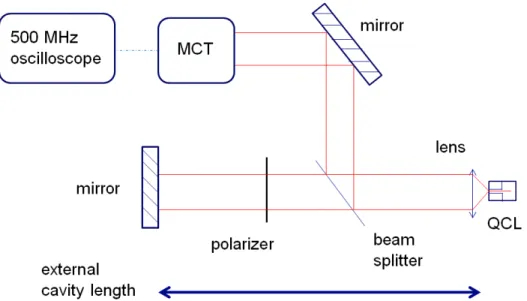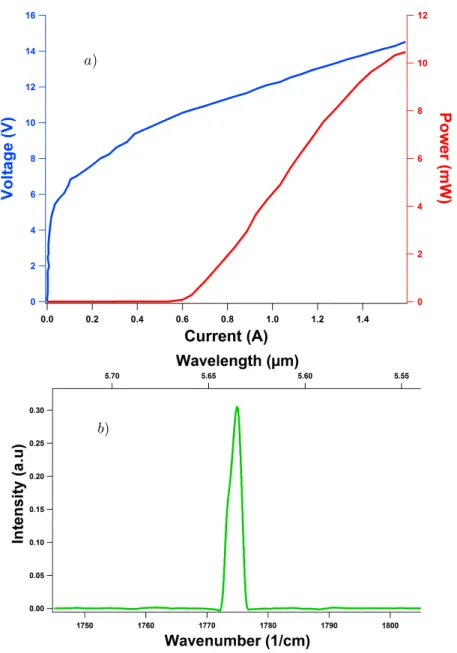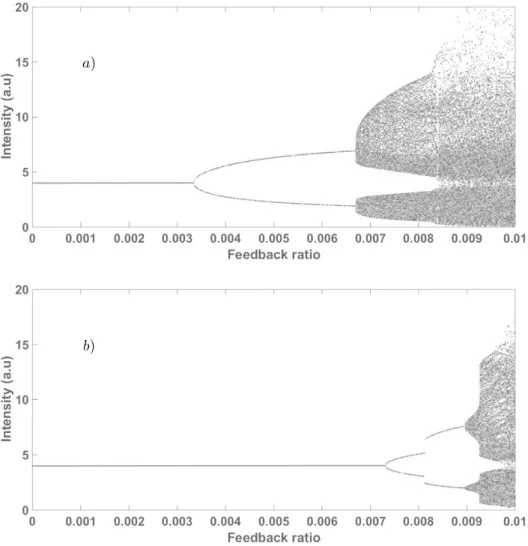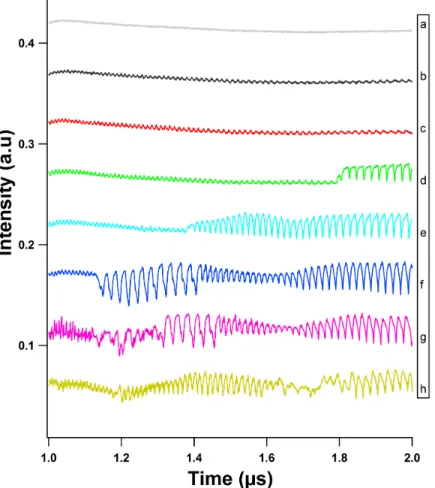HAL Id: hal-02342844
https://hal.telecom-paris.fr/hal-02342844v2
Submitted on 11 Nov 2019
HAL is a multi-disciplinary open access
archive for the deposit and dissemination of
sci-entific research documents, whether they are
pub-lished or not. The documents may come from
teaching and research institutions in France or
abroad, or from public or private research centers.
L’archive ouverte pluridisciplinaire HAL, est
destinée au dépôt et à la diffusion de documents
scientifiques de niveau recherche, publiés ou non,
émanant des établissements d’enseignement et de
recherche français ou étrangers, des laboratoires
publics ou privés.
Temperature dependence of a mid-infrared quantum
cascade laser with external optical feedback
Olivier Spitz, Jiagui Wu, Sudeep Khanal, Mathieu Carras, Benjamin
Williams, Chee Wei Wong, Frederic Grillot
To cite this version:
Olivier Spitz, Jiagui Wu, Sudeep Khanal, Mathieu Carras, Benjamin Williams, et al..
Tempera-ture dependence of a mid-infrared quantum cascade laser with external optical feedback.
Proceed-ings of SPIE, the International Society for Optical Engineering, SPIE, The International Society for
Optical Engineering, 2018, Quantum Sensing and Nano Electronics and Photonics, 10540, pp.58.
�10.1117/12.2290117�. �hal-02342844v2�
Temperature dependence of a mid-infrared quantum cascade
laser with external optical feedback
O. Spitz
a,b,c, J. Wu
c,e, S. Khanal
d, M. Carras
b, B. S. Williams
d, C. W. Wong
c, and F. Grillot
a,c,f aLTCI, T´
el´
ecom ParisTech, Universit´
e Paris-Saclay, 46 rue Barrault, Paris, France
bmirSense, Centre d’Int´
egration NanoInnov, 8 avenue de la Vauve, Palaiseau, France
cFang Lu Mesoscopic Optics and Quantum Electronics Laboratory, University of California
Los Angeles, USA
d
Department of Computer and Electrical Engineering, University of California Los Angeles,
USA
e
College of Electronic and Information Engineering, Southwest University, Chongqing, China
fCenter for High Technology Materials, University of New-Mexico, Albuquerque, USA
ABSTRACT
Quantum cascade lasers (QCLs) exploit radiative intersubband transitions within the conduction band of semi-conductor heterostructures. The wide range of wavelengths achievable with QCLs, from mid-infrared to terahertz range, leads to a large number of applications including absorption spectroscopy, optical countermeasures and free space communications requiring stable single-mode operation with a narrow linewidth, high output power and high modulation bandwidth. Prior work has unveiled the occurrence of temporal chaos in a QCL subjected to optical feedback, with a scenario involving oscillations at the external cavity frequency and low-frequency fluctuations. The purpose of this work is to further investigate the temperature dependence of a mid-infrared QCL with optical feedback. When the semiconductor device is cooled down to 170K, experiments unveil that the laser destabilization appears at a lower feedback ratio and that the chaotic bubble slightly expands owing to a different carrier lifetime dynamics. These results are of paramount importance for new mid-infrared applications such as chaos-encrypted free-space communications or unpredictable countermeasures.
Keywords: Quantum cascade laser, mid-infrared, distributed feedback, optical feedback, non-linear dynamics
1. INTRODUCTION
Quantum cascade lasers (QCLs) are unipolar semiconductor lasers based on intersubband transitions within the conduction band.1 Mid-infrared QCLs can operate in single or multimode configuration, in pulsed or continuous-wave operation,2 at room temperature with thermo-electrical cooling, and have therefore become privileged sources for gas spectroscopy, free-space communications or optical countermeasures.3 The spectacular
development of QCL raises many interrogations regarding the stability of such lasers as little is known on their nonlinear and dynamical properties. For instance, a few theoretical studies have predicted enhanced stability for QCLs operating under external optical feedback or injection-locking.4,5 In particular, optical injection-locking
has demonstrated its strong potential for noise reduction or mode selection in widely tunable QCL sources.6 In
laser diodes, it is known that any source of parasitic optical feedback back to the cavity can easily destabilize the laser hence leading to the emergence of irregular and unpredictable chaotic pulsations as well as various dynamical instabilities.7 Owing to their large damping factor, QCLs are indeed touted for their higher stability
compared to interband laser diodes, in particular when subjected to external optical feedback.4 However, recent
experiments have shown that by applying sufficiently strong optical feedback, the QCL can be driven into a chaotic regime of operation.8 The initially steady signal started to oscillate and then low frequency fluctuations
Further author information: (Send correspondence to O.S.) O.S.:E-mail: olivier.spitz@telecom-paristech.fr
were observed in the laser’s output. In addition, experiments have proved that the route to chaos was not as-sociated to the undamping of the relaxation oscillations, which strongly differ from what is commonly observed in any interband semiconductor lasers.9 This particular feature comes as a direct consequence of the ultrafast
carrier dynamics of the intersubband transitions, which transfers into a carrier-to-photon lifetime ratio that is about four orders of magnitude smaller than in interband lasers. This work goes a step beyond by investigating the evolution of a single mode QCL dynamics emitting at 5.63 µm, for two different temperatures, namely 290K and 170K. When the laser is cooled down to 170K, experiments unveil that the laser destabilization appears at a lower feedback ratio and that the chaotic bubble expands owing to a different carrier-to-photon lifetime ratio. Overall, these novel insights in QCL dynamics are meaningful for controlling and understanding the intersubband dynamics with the view of developing future secured atmospheric transmission lines and unpredictable optical countermeasure systems.
2. EXPERIMENTAL SETUP AND DEVICE DESCRIPTION
The setup used to carry out the measurements is described on Fig.1. For room temperature measurements (290K), the QCL is placed on a mount covered with copper. In order to ensure good thermal conductivity, a thin indium foil is placed between the QCL package and the copper part. Temperature control is achieved thanks to a Peltier module and heat is dissipated with a copper heatsink composed of multiple crenelations. For low temperature measurements, a cryostat with a ZnSe optical window is used. The QCL package is mounted on a copper mount inside a vacuum chamber and a quasi-continuous flow of liquid nitrogen keeps the device at the temperature of interest, the latter being checked thanks to a temperature sensor placed on the copper mount. The vacuum chamber is continuously pumped and pressure as low as 1 nanobar is achieved to insulate the laser from the outside temperature and to prevent condensation on the device. The QCL is placed in front of a mid-infrared lens so that the beam is collimated. This beam hits a 60/40 beam splitter that allows the light to be divided in two paths. The transmission path also contains a mid-infrared polarizer and a golden mirror. The polarizer is used to control the amount of optical feedback which is back-reflected by the mirror to the laser knowing that the QCL light is TM polarized. The feedback ratio f is defined as the ratio between the back-reflected power that couples inside the laser cavity and the total power emitted by the laser. It is thus possible to reach an optical feedback ratio ranging from 0 to 0.235 for room temperature experiments because the QCL light hits the beam splitter as a P-polarized wave. When a cryostat is used to reach a temperature of 170K, the QCL needs to be inserted in a vacuum chamber and this induces a rotation of 90 degrees compared to the previous case. The maximum reachable feedback becomes 0.086 because the QCL light hits the beam splitter as an S-polarized wave. Uncertainty about the feedback ratio, coming from polarizer and lens transmission, taken as 70%, can be estimated at 10% of the total value. The golden mirror is placed on a rail that is accurately controlled thanks to a thread. One can therefore choose the feedback cavity length, standing for the distance between the laser and the feedback mirror, between 30 and 60 cm.
The reflection path is set with a Mercury-Cadmium-Telluride (MCT) camera made for mid-infrared wavelength and with a high bandwidth of 1 GHz. The signal retrieved is then amplified before being analyzed with a real time oscilloscope at 500 MHz. For each measurement, a time trace of one million points was recorded with the oscilloscope, giving access to a dozen of pulses. Pulses are 2 µs long, but because of the transient regime, only the last 1 µs are of interest to study the dynamics of the laser. This allows reaching thermal stability inside the laser whose carrier and photon lifetimes are of several picoseconds.7 It is of first importance to recall that
QCLs do not exhibit any relaxation oscillations owing to the ultrafast intersubband dynamics.10 Therefore the
bandwidth of the detector is satisfactory because the laser destabilization will take place at the external cavity frequency, which is typically of the order of a few hundreds of MHz.7
Figure 1. Experimental setup with the feedback path allowing controlling the back-reflected light and the detection path
The measurements were carried out with a QCL emitting at 5.63 µm. The laser is 2 mm long and 14 µm wide. Single mode emission is performed using a top metal grating cladding with a grating coupling efficiency of 4 cm−1 leading to a distributed feedback (DFB) laser.11 Below the grating, the laser active region is made of 30 periods of AlInAs/GaInAs grown by molecular beam epitaxy on an InP cladding. Because the laser is biased with a quasi-continuous wave inducing a strong warm-up, one needs to optimize the thermal dissipation of the QCL and this is the reason why it is episide-down mounted with gold-tin soldering on AlN substrate. A schematic of the device is shown on Fig.2.
Figure 2. Schematic of the QCL technology; the size of active region and claddings are magnified compared to the real size : substrate size should be one hundred times the one of the active region; courtesy of Ref.12
Fig.3 (a) depicts the light intensity voltage (LIV) characteristics of the free-running QCL under study. The threshold current is of 590 mA for a voltage of 10 V when biased at 290K with a 300 ns pulse at a repetition rate of 100 kHz, standing for a 3% duty cycle. The wall-plug efficiency of this laser at maximum output power is 0.05%. Fig. 3 (b) shows the optical spectrum collected from the Fourier transform infrared spectrometer (FTIR). As expected, the optical spectrum is perfectly single mode and the DFB peak is at 1775 cm−1 hence 5.63 microns.
a)
b)
Figure 3. LIV (a) and spectral (b) characteristics of the free-running QCL operating at room temperature (290K) and under pulsed wave with 3% duty cycle
3. NUMERICAL SIMULATIONS
In interband lasers, the carrier-to-photon lifetime ratio T is of the order of 103 and of primary importance for
the study of the non-linear dynamics.13 One way of analyzing the dynamics under optical feedback is based on
the Lang and Kobayashi model14 whose dimensionless equations are given by,
dY ds = (1 + iα)ZY + ηe (−iΩ0θ)Y (S− θ) , (1) TdZ ds = P − Z − (1 + 2Z)|Y | 2, (2)
With s the normalized time with respect to the photon lifetime τp, Y the normalized complex electric field
and Z the normalized carrier density. α stands for the linewidth enhancement factor (LEF), which governs the phase-amplitude coupling within the laser’s cavity.15 Ω0 is the normalized laser frequency above threshold, θ is
P = τpGNNth
2 (
I Ith− 1) ,
(3)
Where GN is the differential gain and Nththe carrier density at threshold.
In Equation (1), η is the normalized feedback coefficient and scales as:
η = τp τin
2Cl
√
f , (4)
Where Cl is the coupling strength coefficient of the front facet that is coupled to the external cavity16 and τinthe photon roundtrip time in the laser cavity. Although the LEF can slightly vary with temperature because
of the thermal effects and gain compression, our experimental conditions allow remaining within the quasi-static regime. Indeed, the typical frequency above which the modulation response of a QCL reaches a plateau leading to a steady LEF is below 100 MHz.17 The external cavity frequency is of several hundreds of MHz when optical
feedback is applied and thus does not affect the LEF.
a)
b)
Figure 4. Numerical bifurcation diagram for a linewidth enhancement factor α=1.7, an external cavity length of 30 cm, a pump parameter P=4 and a carrier-to-photon lifetime (a) T =1800 or (b) T=1000
As aforementioned, the T-parameter is fundamental in driving the nonlinear dynamics of semiconductor lasers under external optical feedback. For instance, Fig.4 (a) and Fig.4 (b) depict the bifurcation diagrams in the case of an interband laser with either T=1800 (a) or T=1000 (b). In this simulation, the chaotic bubble is likely to expand when T increases. For instance, the first Hopf bifurcation takes place for a value of f = 0.0033 when T=1800 whereas it appears at f=0.0072 for T=1000. Furthermore, the chaotic bubble is hardly detected at T=1000 for f≤ 0.01 but strongly emerges at T=1800. This difference can be experimentally observed by changing the carrier lifetime through the temperature operation. Similar behaviors can be predicted for QCLs with different values of the T-parameter∗. QCLs exhibit a carrier-to-photon lifetime that can be four to five orders of magnitude below that of interband lasers.6 A custom heterostructure simulation software based on
semi-classical Boltzmann equations was used to retrieve the carrier lifetime of our QCLs by defining the width and doping of every single layers inside the laser under study.18 Numerical simulations depicted in Tab.1below
unveil a possible increase of the carrier-to-photon lifetime ratio by several orders of magnitude when cooling down the temperature operation of the QCL.
Table 1. Calculated carrier and photon lifetimes of the DFB QCL for the two temperatures of interest
Temperature (Kelvin) Carrier lifetime (ps) Photon lifetime (ps) T
170 0.57 4.7 0.12
290 0.37 4.7 0.08
4. EXPERIMENTAL RESULTS
The QCL is biased with a quasi-continuous source emitting a 2 µs pulse at 1.8 times the threshold current in order to have a strong detected signal overcoming the noise. The cavity length is set at 35 cm, which corresponds to an external cavity frequency of 430 MHz falling within the bandwidth of the detector. The time traces at 290K, presented on Fig.5, show the evolution of the laser dynamics as a function of the feedback strength. The feedback ratio is controlled thanks to the polarizer angle and in that particular case, the maximum feedback ratio that can be achieved is 0.235 due to the P-polarized wave coming from the QCL. When no back-reflected light comes to the QCL, the time trace is unchanged and the laser remains perfectly stable. For a feedback ratio as low as 0.002, oscillations start appearing and the first Hopf bifurcation is reached. Patterns related to low frequency fluctuations, standing for deterministic chaotic dynamics, can then be observed for feedback ratios above 0.019. The low frequency fluctuation dynamics usually show a competition between a fast oscillation and the slow power dropout frequency occurring around 50 MHz as shown on Fig.5. Besides, compared to our prior studies where inverted low frequency fluctuations were unveiled, the observed patterns are more similar to those observed in interband diode lasers.7 The explanation for such differences is still under investigation but might be due to the pulse operation hence creating different interference conditions within the laser cavity. For feedback ratios between 0.019 and 0.031 the signal seems to be driven by two frequencies while for higher feedback ratios, up to the maximum values of 0.235, many erratic frequencies appear and lead to a third behavior. Overall, the various dynamical states that are observed are qualitatively in agreement with our prior observations.8
Figure 5. Experimental time traces of the QCL under optical feedback at 290K. The polarizer allows achieving value of feedback ratio f between 0 and 0.235. a) f = 0. b) f = 0.002. c) f = 0.010. d) f = 0.019. e) f = 0.031. f) f = 0.068. g) f = 0.119. h) f = 0.235
The same experiment was then carried out at 170K using a cryostat and liquid nitrogen. The laser light becomes S-polarized in that configuration and the maximum reachable feedback is 0.086. The time traces on Fig. 6 show similar dynamical behaviors with the experimental work at 290K. However, in this case, the destabilization of the laser starts for lower values of the feedback ratio. For instance, the regime of low frequency fluctuations takes place for a feedback ratio f = 0.008 instead of 0.019 at 290K. Further investigations are required to fully characterize the low frequency fluctuation regime but overall we show here that the route to chaos tends to slightly expand at a lower temperature operation. This phenomenon results from the increase of the carrier-to-photon lifetime ratio due to the strong temperature dependence of the electron-electron and electron-phonon scatterings.
5. CONCLUSIONS
In this article, the temporal dynamics of a mid-infrared QCL has been investigated at two different tempera-tures. At room temperature, the same dynamical regimes as those already observed have been identified with the birth of periodic and chaotic oscillations. When the laser is cooled down to 170K, experiments have qual-itatively unveiled that the laser destabilization takes places at a lower feedback ratio. This effect is confirmed by a numerical analysis showing that the carrier-to-photon lifetime ratio increases between 290K and 170K. Overall, this work brings novel insight on nonlinear dynamics of quantum cascade oscillators operating under optical feedback. Possible applications are secured atmospheric transmission lines and unpredictable optical
Figure 6. Experimental time traces of the QCL under optical feedback at 170K. The polarizer allows achieving value of feedback ratio fr between 0 and 0.086. a) f = 0. b) f = 0.0001. c) f = 0.004. d) f = 0.008. e) f = 0.038. f) f = 0.065. g) f = 0.086
countermeasures systems.
ACKNOWLEDGMENTS
This work is supported by the French Defense Agency (DGA), Office of Naval Research (ONR) and National Science Foundation (NSF).
REFERENCES
[1] Faist, J., [Quantum Cascade Lasers ], Oxford University Press (2013).
[2] Capasso, F., “High-performance midinfrared quantum cascade lasers,” Opt. Eng. 49, 102–111 (2010). [3] Capasso, F., Paiella, R., Martini, R., Colombelli, R., Gmachl, C., Myers, T. L., Taubman, M. S., Williams,
R. M., Bethea, C. G., Unterrainer, K., Hwang, H. Y., Sivco, D. L., Cho, A. Y., Sergent, A. M., Liu, H. C., and Whittaker, E. A., “Quantum cascade lasers: Ultrahigh-speed operation, optical wireless communication, narrow linewidth, and far-infrared emission,” IEEE J. Quant. Electron. 38, 511–532 (2002).
[4] Mezzapesa, F. P., Columbo, L. L., Brambilla, M., Dabbico, M., Borri, S., Vitiello, M. S., Beere, H. E., Ritchie, D. A., and Scamarcio, G., “Intrinsic stability of quantum cascade lasers against optical feedback,”
[5] Renaudat St-Jean, M., Amanti, M. I., Bernard, A., Calvar, A., Bismuto, A., Gini, E., Beck, M., Faist, J., Liu, H. C., and Sirtori, C., “Injection locking of mid-infrared quantum cascade laser at 14 GHz, by direct microwave modulation,” Laser Photonics Rev. 8, 443–449 (2014).
[6] Juretzka, C., Simos, H., Bogris, A., Syvridis, D., Els¨asser, W., and Carras, M., “Intensity noise properties of mid-infrared injection locked quantum cascade lasers: II. experiments,” IEEE J Quant. Electron. 51, 1–8 (2015).
[7] Jumpertz, L., Schires, K., Carras, M., Sciamanna, M., and Grillot, F., “Chaotic light at mid-infrared wavelength,” Light : Science and Applications 5 (2016).
[8] Jumpertz, L., Carras, M., Schires, K., and Grillot, F., “Regimes of external optical feedback in 5.6 µm distributed feedback mid-infrared quantum cascade lasers,” Appl. Phys. Lett. 105 (2014).
[9] Kane, D. M. and Shore, K. A., [Unlocking Dynamical Diversity: Optical Feedback Effects on Semiconductor
Lasers ], Wiley (2005).
[10] Sciamanna, M. and Shore, K. A., “Physics and applications of laser diode chaos,” Nat. Photon. 9, 151–162 (2015).
[11] Carras, M., Maisons, G., Simozrag, B., Garcia, M., Parillaud, O., Massies, J., and Marcadet, X., “Room-temperature continuous-wave metal grating distributed feedback quantum cascade lasers,” Appl. Phys.
Lett. 96 (2010).
[12] Ferr´e, S., “Optimisation and new architectures for high power mid-infrared quantum cascade lasers.” PhD dissertation, Universit´e Pierre et Marie Curie (2016).
[13] Jumpertz, L., [Nonlinear Photonics in Mid-infrared Quantum Cascade Lasers ], Springer International Pub-lishing (2017).
[14] Lang, R. and Kobayashi, K., “External optical feedback effects on semiconductor injection laser properties,”
IEEE J. Quant. Electron. 16, 347–355 (1980).
[15] Henry, C. H., “Theory of the linewidth of semiconductor lasers,” IEEE J. Quant. Electron. 18, 259–264 (1982).
[16] Grillot, F., “On the effects of an antireflection coating impairment on the sensitivity of optical feedback of AR/HR semiconductor DFB lasers,” IEEE J. Quant. Electron. 45, 720–729 (2009).
[17] Hangauer, A., Spinner, G., Nikodem, M., and Wysocki, G., “High frequency modulation capabilities and quasi single-sideband emission from a quantum cascade laser,” Opt. Express 22 (2014).
[18] Trinit´e, V., Ouerghemmi, E., Gu´eriaux, V., Carras, M., Nedelcu, A., Costard, E., and Nagle, J., “Modelling of electronic transport in quantum well infrared photodetectors,” Infrared Phys. Technol. 54, 204–208 (2011).





